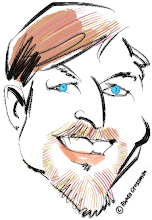We used big balls of colored embroidery floss, so the web is a bit fine and hard to see with my camera phone pictures. You may need to click on the picture to see a zoomed in version.
The web extended its reach beyond the living room, into the kitchen, dining room and front and side halls! Timothy is very proud of our work together.
Tuesday, April 28, 2009
Sunday, April 26, 2009
Currencies as DNA of Social Organisms
I just posted a reply to a post about currencies as the DNA of social organisms on New Currency Frontiers Blog and wanted to cross-post it here.
Many people seem to struggle with the "social organism" metaphor. I think that might be a function of two things: 1) loose boundaries which make it difficult to see social level organisms in the usual way we see "things" and 2) wanting to be individually more important than we are.
Boundaries: We are in the habit of seeing the world as objects and identifying objects by their boundaries. Normally, you're sitting across the table over there, and I'm sitting over here, and the boundaries seem pretty obvious and inviolable. Of course, that's an illusion. We're breathing the same air, drinking the same water, eating from the same biological food supplies. We might even go so far has to have a blood transfusion or organ transplant.
Because of the level on which we participate in them, it is hard for us to see the boundaries of social organisms. We are like air/water/bacteria/nutrients or at best like cells with the capacity to move between social organisms. Even more confusing, is the fact that we participate in MULTIPLE social organisms. Surely, my cells are in an exclusive relationship with me, aren't they? (No, in fact they are not.)
Importance: To really see this picture, makes us feel small. To see a company as a social critter, and its departments as organs fulfilling different functions to keep the critter alive, and people as replaceable cells who may come and go with little effect... Surely, that's not right. I'm more important than that!
Unfortunately, this leads us to some very bad ways of thinking. We labor under the illusion that changing the people changes the organism. That good people, will run a company responsibly... or that electing a different President will magically create change.
The only way that real change (other than death/collapse) happens in a social organism is when its structure or DNA is significantly modified. Sometimes a new leader actually does that, but frequently they don't. And what's worse is that some of what needs the most changing is deeply embedded in our assumptions about how things work.
Think of it this way. No matter how creative and enlightened a CEO is, his company is still fueled by the same money as all the other companies. Without the ability to change the fundamental lifeblood of the organism, how much change is actually possible? How much does the structure of that lifeblood force certain responses and behaviors?
Until we embrace our capacities as DNA-constructors of the social organisms we inhabit, they will continue to run amok, be diseased, collapse and deplete our planet.
It's time for us to step up.
Many people seem to struggle with the "social organism" metaphor. I think that might be a function of two things: 1) loose boundaries which make it difficult to see social level organisms in the usual way we see "things" and 2) wanting to be individually more important than we are.
Boundaries: We are in the habit of seeing the world as objects and identifying objects by their boundaries. Normally, you're sitting across the table over there, and I'm sitting over here, and the boundaries seem pretty obvious and inviolable. Of course, that's an illusion. We're breathing the same air, drinking the same water, eating from the same biological food supplies. We might even go so far has to have a blood transfusion or organ transplant.
Because of the level on which we participate in them, it is hard for us to see the boundaries of social organisms. We are like air/water/bacteria/nutrients or at best like cells with the capacity to move between social organisms. Even more confusing, is the fact that we participate in MULTIPLE social organisms. Surely, my cells are in an exclusive relationship with me, aren't they? (No, in fact they are not.)
Importance: To really see this picture, makes us feel small. To see a company as a social critter, and its departments as organs fulfilling different functions to keep the critter alive, and people as replaceable cells who may come and go with little effect... Surely, that's not right. I'm more important than that!
Unfortunately, this leads us to some very bad ways of thinking. We labor under the illusion that changing the people changes the organism. That good people, will run a company responsibly... or that electing a different President will magically create change.
The only way that real change (other than death/collapse) happens in a social organism is when its structure or DNA is significantly modified. Sometimes a new leader actually does that, but frequently they don't. And what's worse is that some of what needs the most changing is deeply embedded in our assumptions about how things work.
Think of it this way. No matter how creative and enlightened a CEO is, his company is still fueled by the same money as all the other companies. Without the ability to change the fundamental lifeblood of the organism, how much change is actually possible? How much does the structure of that lifeblood force certain responses and behaviors?
Until we embrace our capacities as DNA-constructors of the social organisms we inhabit, they will continue to run amok, be diseased, collapse and deplete our planet.
It's time for us to step up.
Tuesday, April 14, 2009
Subscribe to:
Comments (Atom)












